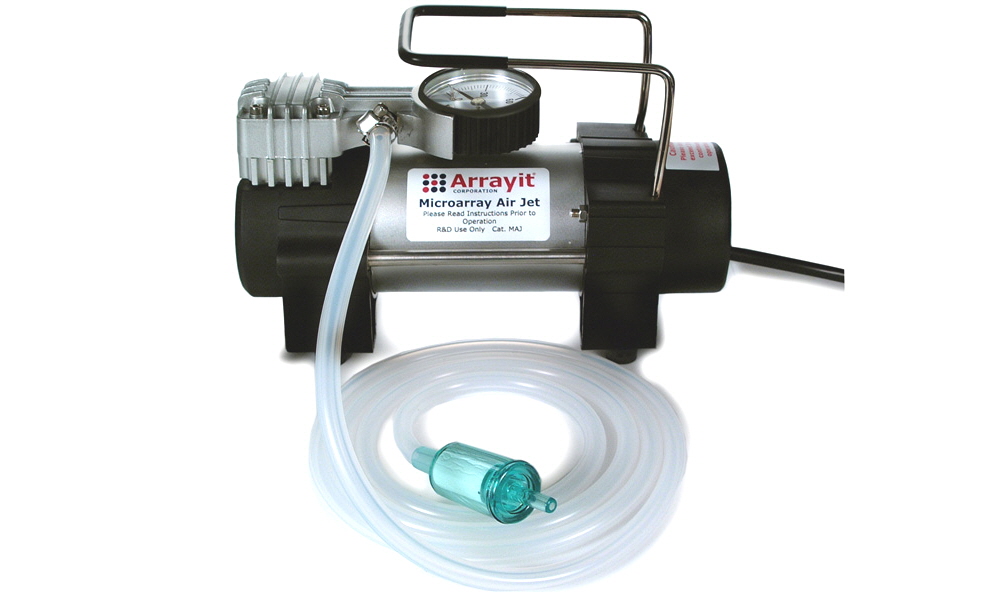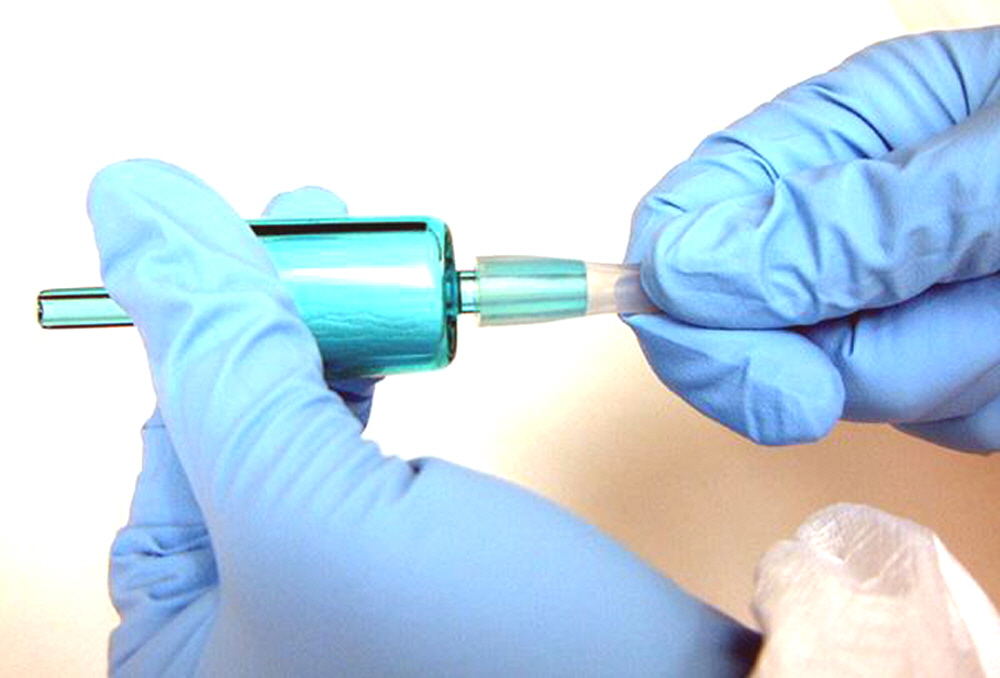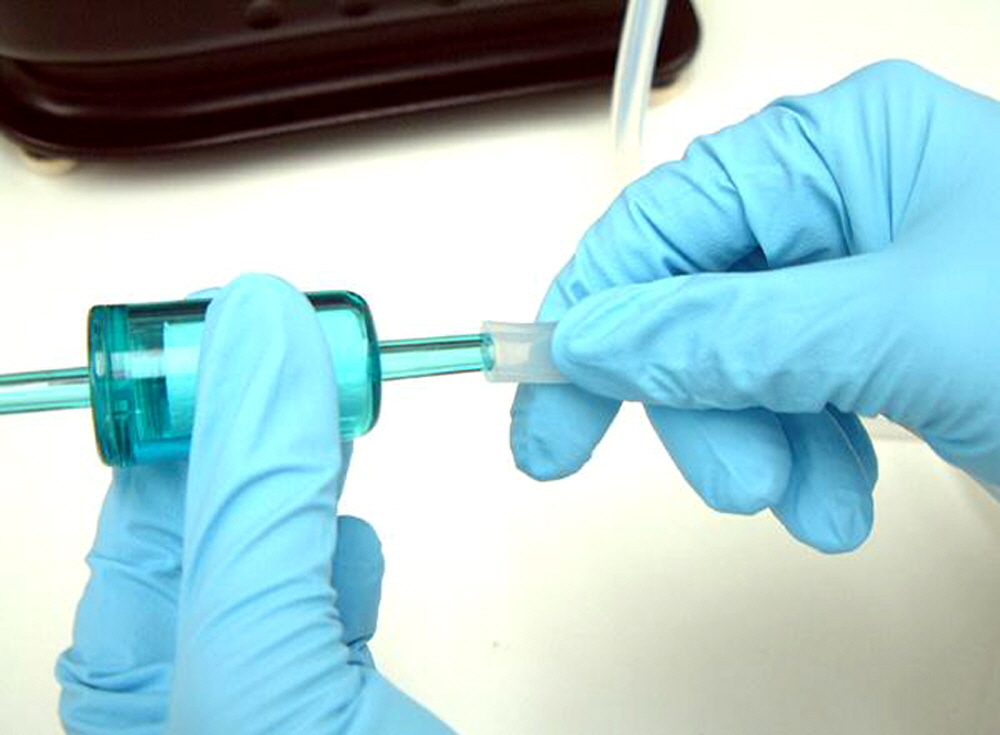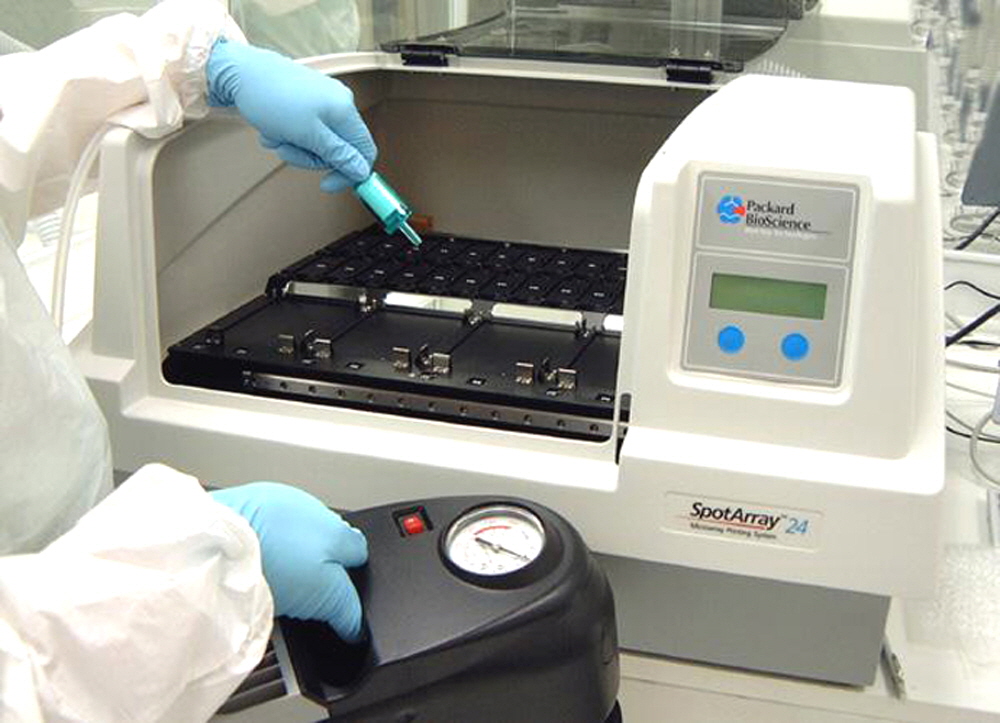Air Jets
Data Sheet
![]() Shop this product in our online store
Shop this product in our online store
Arrayit | Microarray air jets MAJ filtered force air laboratory drying applications pins printheads 110 220 volt life sciences research
Instruments - Microarray Processing - Microarray Air Jets

The Arrayit Microarray Air Jet provides a highly pressurized particle-free air stream for microarray printing pin and printhead drying as well as many other applications in the life sciences. This instrument is highly recommended for all microarray laboratories as a replacement for “house air” and air canisters, which are often contaminated with oils, organic compounds and particles that can contaminate pins and printheads and other implements requiring highly purified air. The Air Jet also finds use for removing glass shards and other particulate materials from the decks of microarrayers between manufacturing runs.
Table of Contents
Introduction
Quality Control
Product Description
Technical Note
Technical Assistance
Short Protocol
Complete Protocol
Recommended Equipment
Troubleshooting Tips
Ordering Information
Warranty
Introduction
Congratulations on taking a big step towards improving the economies of scale, quality and speed of your microarray research. This booklet contains a complete set of illustrations and protocols outlining the steps and principles needed to use the ArrayIt® Microarray Air Jet (MAJ).
Quality Control
Arrayit assures the performance of this product. The finest scientific research went into the development of this product. Rigorous quality control monitoring of each instrument guarantees that our Microarray Air Jets conform to the highest scientific standards.
Product Description
Arrayit's ArrayIt® Microarray Air Jet (MAJ) provides the only portable air jet on the market, and does so at an affordable price. The particle-free air stream can be used to remove water droplets, dust and other contaminants from arrayers, scanners, pins, cover slips and other items.
Users will appreciate the following features of our Microarray Air Jet (MAJ):
- High speed air stream of 6 m/sec (11 knots)
- High air flow rate of 450 cm^3/sec (0.9 cfm)
- Standard operating pressure of 100 g/cm^2 (2 psi)
- 99.999% air filtration (converts ambient air into class 1 rating!)
- Removes particles down to 0.01 µm diameter
- Sterile air stream for microbial applications
- Near zero organic contamination
- Cleanroom compatible
- Portability provides ease-of-use in any laboratory
- Durable, impact resistant casing
- Vibration dampener pad reduces vibration and assures stationary operation
- Remove glass shards and other tiny debris from arrayer platens
- Remove dust and debris from scanners and microscopes
- Remove water droplets from microarray pins and hybridization cassettes
- Remove dust from glass cover slips
- Major improvement over unfiltered “house” air systems
- Built-in pressure meter to monitor filter back pressure
- Transparent hose allows contamination monitoring
- In-line filters are inexpensive and easy to replace (Catalog MAJF)
- Non-scuffing rubber feet
- Affordable for any research laboratory
- 2 meter (6 ft) air hose and 2 meter (6 ft) electrical cord
- Lightweight at 2.9 kg (6.4 lbs.)
- Uses standard 120 volt electrical outlets
- MAJ220 has an in-line voltage converter for 220 volt laboratories
Technical Note
The Microarray Air Jet (MAJ) generates a powerful pressurized air stream of >5 meters/sec, which may be dangerous if used incorrectly. Do not direct the air stream towards your eyes or face during operation, and do not place the air outlet directly against your skin at any time. This instrument generates considerable heat during use, and is intended for intermittent use only. Continuous operation should not exceed 5 min intervals.

Figure 1. Microarray Air Jet in pin drying. The Air Jet can be used to rapidly propel water droplets out of the channels of Micro Spotting pins prior to microarray printing or storage.
Technical Assistance
Please contact us if you have any comments, suggestions, or if you need technical assistance. By electronic mail: arrayit@arrayit.com (under the subject heading, please type, “Technical assistance”). By email: arrayit@arrayit.com, Monday–Friday, PST 9:00am - 4:30pm. Please remember that we want to hear about your successes!

Figure 2. Microarray Air Jet drying a hybridization cassette. The Air Jet can be used to rapidly propel water droplets out of hybridization cassettes prior to use.
Short Protocol (Steps 1-6):
1. Remove the Microarray Air Jet (MAJ) from the shipping box.
2. Place the Air Jet on a stable surface.
3. Power the instrument “on” by pressing the red button.
4. Direct the pressurized air stream using the air outlet nozzle.
5. Dry or decontaminate instruments or implements are needed.
6. Power the unit “off” by pressing the red button.
Complete Protocol (Steps 1-6):
1. Remove the Microarray Air Jet (MAJ) from the shipping box. Remove the instrument from the shipping box and discard the packaging material. For cleanroom use, topically decontaminate the instrument with forced air and 100% ethanol, transport the decontaminated instrument into the cleanroom vestibule or changing room, don the appropriate cleanroom attire, and transport the Air Jet into the cleanroom.
2. Place the Air Jet on a stable surface. Place the Air Jet on a bench top, the laboratory floor or some other stable surface. Placing the instrument on the floor is sometimes convenient as the Air Jet generates considerable noise during use. The 2-meter (6 ft) air hose and 2-meter (6 ft) electrical cord allow the air stream to be directed to most bench top locations. The instrument may “walk” slightly on uneven surfaces, so make sure instrument is placed on a backbench location to prevent any risk of toppling.

Figure 3. Microarray Air Jet has a pressure gauge. The Air Jet (original version shown) contains a built-in air pressure gauge to monitor backpressure during use. A reading of 5 pounds per square inch (5 psi) or greater indicates that the in-line filter is clogged and needs replacing. The power switch (red button) is in the “on” position in this photograph.
3. Power the instrument “on” by pressing the red button. Plug the electrical cord into a standard 120-volt electrical outlet and power the instrument on by depressing the red button on the top of the unit. Depressing the red button in the opposite manner will power the Air Jet off.

Figure 4. Microarray Air Jet filter removal. The Air Jet filter is removed from the air hose by pulling the tubing off the filter spindle as shown.
4. Direct the pressurized air stream using the air outlet nozzle. Place the in-line air filter in your finger tips and use the tapered outlet to direct the air stream onto the arrayer platen, scanner, Micro Spotting pins, cover slips, hybridization cassettes or any other implement that contains water droplets or debris that needs removing (Figs. 1 and 2). The pressure gauge should read “0 psi” during all normal operation, and a meter reading of 5 psi or greater suggests that the in-line filter needs replacing (see Figs. 4 and 5) or that the air stream is being blocked from exiting the outtake nozzle. Do not block the outtake nozzle at any time during use. The in-line filter can be changed by disconnecting the air hose from the filter unit, which is accomplished by pulling outward on the filter unit (Fig. 4). The air hose fits snuggly, so a considerable pulling force is required to disconnect the filter. Insert the new filter unit by pressing the male fitting over the flexible air hose (Fig. 5). Please note that airflow through the filter unit is directional, such that the narrower end of the filter unit should be connected to the air hose and the air stream should exit out the nozzle on the wider end of the filter unit (Fig. 5). Inserting the filter unit backwards will reduce airflow considerably.

Figure 5. Microarray Air Jet filter replacement. The Air Jet filter is replaced by inserting a new filter (MAJF) onto the air hose by pressing the tubing over the filter spindle on the narrower end of the filter unit.
5. Dry or decontaminate instruments or implements are needed. The force of the air stream can be adjusted by varying the distance between the nozzle and the surface that is being decontaminated. Glass shards, particulates, water droplets, dust, fibers, and many other types of surface contaminants can be removed from the arrayer platens, scanners, and any other laboratory instrument or implement that requires a high-pressure source of particle-free air. The Air Jet generates heat during use and should only be used continuously for 30 second intervals. The Air Jet is not designed for continuous use and may present an overheating or fire hazard if used in this manner. Never leave the Air Jet on for more than 30 consecutive seconds.
6. Power the unit “off” by pressing the red button. Press the power button into the “off” position immediately after each use.

Figure 6. Microarray Air Jet (original version) in platen decontamination. The Air Jet can be used to remove tiny glass shards and other particulates from microarray platens that accumulate during microarray manufacturing (Perkin Elmer SpotArray 24 shown).
Recommended Equipment
SpotBot Personal Microarrayer
Stealth Micro Spotting Device
Super Microarray Substrates
High Throughput Wash Station
Microarray High-Speed Centrifuge
Microarray Hybridization Cassette
Troubleshooting Tips
Backpressure on pressure gauge:
- Filter requires changing (replace with Catalog I.D. MAJF)

